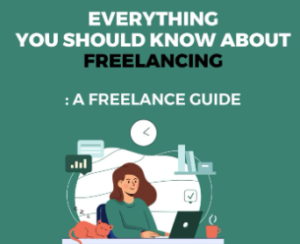 A Step-by-Step Guide to Marketing for Freelancers
A Step-by-Step Guide to Marketing for Freelancers
By Cara Siera
For most freelancers, there’s no marketing or advertising team you can rely on to hawk your services. The task of marketing yourself falls to you and you alone.
How can you make the most of it—both your time and your advertising dollars? Below, we’ll discuss the simple steps you can take to get your name and reputation in front of potential customers.
Step 1: Professional Documents
Even as a freelancer, some of your clients may require a bit of a “traditional” application process. It is advisable to have a resume, cover letter, and portfolio ready-made for them.
Of course, you will need to tailor your documents to each client. How can you do this in a hurry? You can use ChatGPT to edit your cover letter and resume. For example, you can copy and paste your cover letter into the text generator along with the prompt “Optimize this cover letter for…” and link to the company’s website. Make sure you double-check the output and edit it for accuracy and honesty.
While you’re looking at your resume, use it to populate a LinkedIn profile if you haven’t already done so. We’ll talk more about the need for this in the next section.
Step 2: Online Presence
- Team Stage reports that 73 percent of freelancers look for work online. This underscores how important having an online presence is.
- It’s been said that if you don’t have an online presence, you don’t exist. Most clients and customers want the reassurance of a website (or at least a Facebook page) to prove that you’re a legitimate player.
- So, back to that LinkedIn page we mentioned earlier. LinkedIn is a professional networking platform. As such, it’s more respected than other social media platforms. It’s also designed to highlight your skills and accomplishments. If you don’t do anything else on this list, make a LinkedIn profile!
You can also use personal websites, blogs, social media, and guest posts to secure an online presence. For polished, eye-catching visuals on all these channels, try using InsMind’s easy AI photo editing tools to enhance images and create professional-quality content quickly Create a LinkTree to connect them all together within a single link. Next, we’ll talk about how to make sure all those elements fit together.
Step 3: Personal Branding
Your personal brand is the sum total of your public image, especially how you are perceived by others in the professional sphere. There are several ways you can approach the intentional process of crafting this image.
First, audit your channels. This is especially important in the age of social media. Likely, you’ve had social media since adolescence. Perhaps not everything you’ve posted in that time coincides with how you want to be seen now. Audit your social feeds, paying special attention to the following.
-
- Set personal feeds as “private.” Only allow your business feeds to be public.
- Because of your connections, others may still be able to see private posts. Look through past photos, posts, and comments, and delete any that express inflammatory opinions (such as your political views), use explicit language, or show unprofessional behavior (such as partying or anything illegal). Don’t forget to audit your comments on others’ posts or posts they’ve tagged you in.
- Google your name and see what comes up. If you’re not happy with something, delete it or ask the owner to delete it.
Once you’ve cleaned up your online presence, it’s time to design how you want to be seen. First, decide on your values and mission. Think about what types of posts would align with these.
Then, consider visual continuity. You want people to recognize you, whether they’re on LinkedIn or Instagram. The easiest way to do this is by using the same headshot for your profile picture. You can also decide on a color scheme, fonts, or filters that you will consistently use in your posts. Design platforms like Canva can make this easier. Don’t forget tangible branding items like business cards or media kits.
Step 4: Advertising
- You might be surprised that we saved advertising for last. The truth is, a single paid ad popping up in people’s browsers likely won’t convert unless you’ve already done the steps above.
- Many freelancers, in fact, find that the above produce enough leads and word-of-mouth recommendations to keep a full schedule. But if you need a few more leads and are ready to start advertising, start slow. You’ll want to test out which platforms and types of ads return the most clicks and conversions.
- As a freelancer, your advertising budget may be limited. The good news is, business profiles on many platforms unlock free trials or advertising credits. Try out Facebook, Google, or LinkedIn and see what works for your business.
-
Many freelancers, in fact, find that the above produce enough leads and word-of-mouth recommendations to keep a full schedule. But if you need a few more leads and are ready to start advertising, start slow. You’ll want to test out which platforms and types of ads return the most clicks and conversions — tools like EmailLabs can help you track and optimize your email marketing performance as part of the process.
Key Takeaways
Building a freelance business is an intensive process. You can get a head start by having your professional documents ready, building an online presence and a personal brand, and taking a thoughtful approach to advertising.
 A Step-by-Step Guide to Marketing for Freelancers
A Step-by-Step Guide to Marketing for Freelancers